MUNSTER SEWAGE LAGOONS
Spring: *** Summer: *** Fall: **** Winter:*
Warning: Sewage lagoons generally do not welcome visitors. Liability insurance is behind much of their reluctance. In the past, they have often made an exception for birders. For some lagoons, the OFNC and/or independent birdwatchers have arranged special access with the operators or wardens. Contact the OFNC to find the current arrangements, if any. Some lagoons are partly visible without crossing the fences, though because of the brem construction, many are not visible from the road. Lagoons are generally not heavily patrolled or impassibly fenced, and when trespassers are unwelcome they are usually just asked to leave; so many birders assume the "No Tresspassing" signs are for someone else (especially given past tolerance). Once in a while, especially in hunting season, hunters make the same assumption. They are less welcome than birders though and are often reported by the locals. After one of these incidents, patrols may be more frequent. The rules seem to change as often as the folks assigned to enforce them; some are more tolerant than others (some are downright helpful). Use courtesy and common sense. And when you park near a sewage lagoon, please don't block the access roads. Even without crossing the fences, a patient and competent birder can see many species as they fly into and out of the lagoons.
Independent Directions to this Site: From Highway 416 take exit 66 (Fallowfield Road). If southbound, a 0.4 km offramp dumps onto Fallowfield, where you will turn right or west. If northbound, the 0.4 km offramp brings you to Fallowfield, where you will turn left or west onto it and in 0.5 km join the southbound offramp traffic. Both groups will now follow Fallowfield Road west 16.5 km to reach Munster Road. Turn left or southeast onto Munster Road and drive 3.8 km, to about a half kilometre past the town of Munster, where you can pulloff to the right or southwest on the shoulder to view parts of the Munster Sewage Lagoons.
Marlborough Forest Loop Route Directions: From the pulloff for the Ruffed Grouse Area, where you are parked to visit the Richmond Fen via Kettles Road area, return the 1.0 km to Munster Road. Turn right or northwest and go 6.3 km, to just beyond Copeland Road, where you can pulloff to the left or southwest on the shoulder to view parts of the Munster Sewage Lagoons.
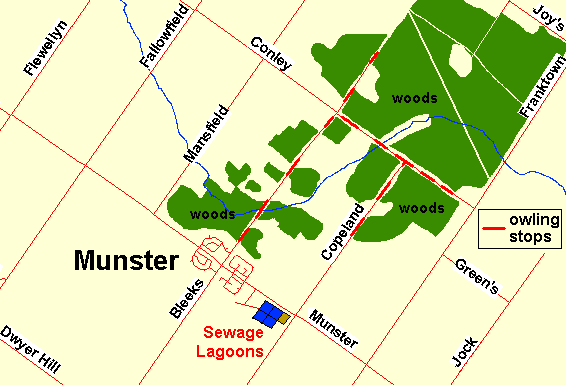 Map of the Munster Sewage Lagoons Area
Map of the Munster Sewage Lagoons Area
Site Description and Birding Information: The four (previously five) ponds at this sewage treatment plant are, collectively, one of the best spots in the Ottawa area to view shorebirds during their spring and fall migrations.
Probably because of liability insurance rate increases, or perhaps to discourage folk from swimming in the ponds or making off with valuable fecal coliformi; Goulbourn Township has recently erected an eight foot fence complete with barbed wire top. The Ottawa Field-Naturalists' Club had an arrangement with the good folks at the township to allow visitations by birders. A small number of keys were available to club members through certain high-ranking club officials. A maximum of 20 birders at a time was allowed. Non-members had to be with a member, since only members were allowed to have keys. It was hoped that one day a better arrangement could be made. But, unfortunately, this arrangement has ended. A call to the OFNC at 722-3050 will provide the most recent developments.
Should no progress be made on gaining access for birders, you can still see some of the area from the road. A scope is useful in any case, but particularly so in the latter instance. Because of the slope of the road, the two (previously three) ponds nearest the road are partly visible from the outside. The lower, or most southeasterly, of these 'three' ponds, has been allowed to dry and fill with vegetation. In the past, it often provided the best shorebird habitat. However, sewage lagoons do not remain static, and any pond can have exposed edges that attract shorebirds, and, of course, the water can attract waterfowl. All the ponds are worth checking. Check the roadways between the ponds too, sometimes shorebirds rest there.
The road into the gate on the west side of the lagoons, where it passes through the fence, provides an elevated viewpoint from which the western ponds can be scanned. Ask permission if anyone is around and don't block the roadway. Also take a moment to scan the field below or south of the lagoons. This appears to be a part of the facility, perhaps an outflow or overflow area. It can be viewed from Copeland Road, just beyond the ponds SW of Munster Road. Sometimes birds rest there.
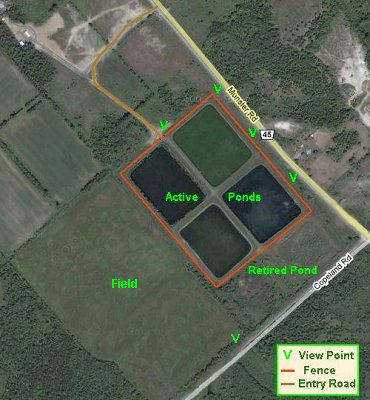 Google Satellite Image Map of Munster Sewage Lagoons
Google Satellite Image Map of Munster Sewage Lagoons
Shorebirds are the feature attraction, but a good variety of waterfowl can also be seen. (Scarcities such as Ruddy Duck are seen in spring and summer and may breed now, Redhead are seen in September and Oldsquaw in November.) Small numbers of raptors looking for a meal occur, including an occasional Merlin and Peregrine Falcon. Black Terns make the odd post-breeding visit. American Pipits put down in late September through mid-October. The site is worth a look anytime between spring thaw and winter freeze-up, but peak times are from mid-May through early June, and again from early July through early November.
Regular shorebirds seen here include: Black-bellied and Semipalmated Plover; Killdeer; Greater and Lesser Yellowlegs; Solitary and Spotted Sandpipers; Sanderling; Semipalmated, Least, White-rumped and Pectoral Sandpipers; Dunlin; Short-billed Dowitcher and Common Snipe.
Less common shorebirds found here, and their most likely timeframes at this site, include: Lesser Golden Plover (August through mid-October), Hudsonian Godwit (mid-September to early November), Baird's Sandpiper (late August through September), Wilson's Phalarope (late May to early June and again in August, no breeders here) and Red-necked Phalarope (late May to early June and again from mid-August through mid-September).
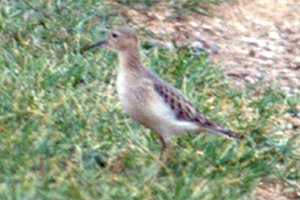 Buff-breasted Sandpiper at Munster Sewage Lagoons - Sept. 24, 1991
Buff-breasted Sandpiper at Munster Sewage Lagoons - Sept. 24, 1991
Rarities that have shown up here include: Yellow-headed Blackbird (Aug. 21, 1994), Ruff (July 11, 1993), Long-billed Dowitcher (Sep. 20, 1992), Willet (July 17, 1992), Buff-breasted Sandpiper (Sep. 24, 1991), Mute Swan (May 1, 1991).
The good citizens of Munster are working hard to have this sewage facility closed. They are, understandably, more concerned with the smell and potential health problems than with providing a stopover for birds. Perhaps a solution similar to that attempted for the Richmond Lagoons could be worked out. For a review of events, see the Friends of Jock River's Munster Sewage Lagoons page.
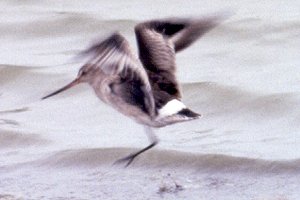
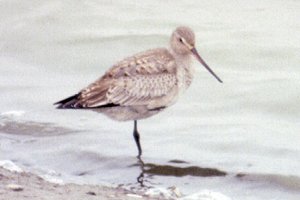 Hudsonian Godwit at Munster Sewage Lagoons - Nov. 11, 1990
Hudsonian Godwit at Munster Sewage Lagoons - Nov. 11, 1990
Marlborough Forest Loop Route Directions: From the pulloff for the Munster Sewage Lagoons, continue northwest on Munster Road 1.1 km to Bleeks Road. Turn right or northeast on it and go far enough to get out of the town of Munster (around 0.5 km). Here you can begin birding the next site on this loop, Bleeks Road.
Return to Marlborough Forest Loop
Return to Birding Ottawa Table of Contents
|




